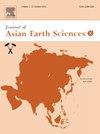Provenance of Middle Jurassic sandstones from the Yuqia depression in the northern Qiadam Basin (NW China): Implications for basin evolution and paleoclimatic conditions
IF 2.3
Q3 GEOSCIENCES, MULTIDISCIPLINARY
引用次数: 0
Abstract
The petrography of 106 clastic rock samples from the Middle Jurassic Dameigou and Shimengou Formations in the Qaidam Basin was analyzed to investigate their provenance and basin evolution. Five distinct sandstone units have been identified from the base of the Dameigou Formation to the top of the Shimengou Formation, hereafter termed as S-I, S-II, S-III, S-IV, and S-V. Petrographic analysis suggests that during the deposition of S-I (Aalenian stage), sediments were sourced from the Qaidam Main Block at the southern margin of the basin and the South Qilian Mountains at the northern margin. However, during the deposition of S-II, S-III, S-IV, and S-V (Bajocian to early Callovian stages), the basin received sediments from the East Kunlun Mountains to the south and the Qilian Mountains to the north. Mineralogical Index of Alteration (MIA) values, along with discrimination diagrams, indicate that the Middle Jurassic climate in the Qaidam Basin transitioned from semi-humid and warm (S-I) to humid and warm (S-II to S-IV), before returning to semi-humid and warm conditions (S-V). A basin evolution model was developed according to our findings, which provide a better understanding in the basin-forming processes and the principle of resource accumulation in the Middle Jurassic.
塔里木盆地北部虞夏坳陷中侏罗统砂岩物源特征:盆地演化与古气候条件
对柴达木盆地中侏罗统大梅沟组和石门沟组106个碎屑岩样品进行了岩石学分析,探讨了碎屑岩的物源和盆地演化。从大梅沟组底部到石门沟组顶部,可识别出5个不同的砂岩单元,分别称为S-I、S-II、S-III、S-IV和S-V。岩石学分析表明,南ⅰ期(阿勒期)沉积主要来源于盆地南缘的柴达木主地块和北缘的南祁连山。而S-II期、S-III期、S-IV期和S-V期(巴约世至早卡洛世)沉积期间,盆地南有东昆仑山脉沉积,北有祁连山沉积。矿物学蚀变指数(MIA)值及判别图表明,柴达木盆地中侏罗世气候由半湿润温暖(S-I)过渡到湿润温暖(S-II - S-IV),再回到半湿润温暖(S-V)。在此基础上建立了中侏罗统盆地演化模型,为进一步认识中侏罗统盆地形成过程和资源聚集规律提供了理论依据。
本文章由计算机程序翻译,如有差异,请以英文原文为准。
求助全文
约1分钟内获得全文
求助全文
来源期刊

Journal of Asian Earth Sciences: X
Earth and Planetary Sciences-Earth-Surface Processes
CiteScore
3.40
自引率
0.00%
发文量
53
审稿时长
28 weeks
 求助内容:
求助内容: 应助结果提醒方式:
应助结果提醒方式:


